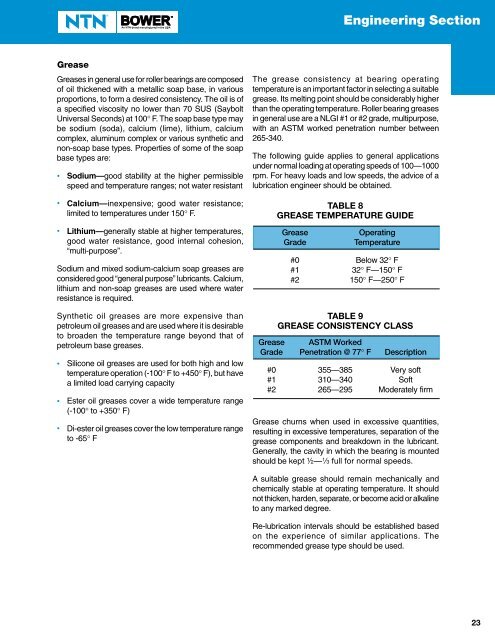You also want an ePaper? Increase the reach of your titles
YUMPU automatically turns print PDFs into web optimized ePapers that Google loves.
Engineering Section<br />
Grease<br />
GREASE<br />
Greases in general use for roller bearings are composed<br />
of oil thickened with a metallic soap base, in various<br />
proportions, to form a desired consistency. The oil is of<br />
a specified viscosity no lower than 70 SUS (Saybolt<br />
Universal Seconds) at 100 F. The soap base type may<br />
be sodium (soda), calcium (lime), lithium, calcium<br />
complex, aluminum complex or various synthetic <strong>and</strong><br />
non-soap base types. Properties of some of the soap<br />
base types are:<br />
• Sodium—good stability at the higher permissible<br />
speed <strong>and</strong> temperature ranges; not water resistant<br />
• Calcium—inexpensive; good water resistance;<br />
limited to temperatures under 150 F.<br />
• Lithium—generally stable at higher temperatures,<br />
good water resistance, good internal cohesion,<br />
“multi-purpose”.<br />
Sodium <strong>and</strong> mixed sodium-calcium soap greases are<br />
considered good “general purpose” lubricants. Calcium,<br />
lithium <strong>and</strong> non-soap greases are used where water<br />
resistance is required.<br />
Synthetic oil greases are more expensive than<br />
petroleum oil greases <strong>and</strong> are used where it is desirable<br />
to broaden the temperature range beyond that of<br />
petroleum base greases.<br />
• Silicone oil greases are used for both high <strong>and</strong> low<br />
temperature operation (-100 F to +450 F), but have<br />
a limited load carrying capacity<br />
• Ester oil greases cover a wide temperature range<br />
(-100 to +350 F)<br />
• Di-ester oil greases cover the low temperature range<br />
to -65 F<br />
The grease consistency at bearing operating<br />
temperature is an important factor in selecting a suitable<br />
grease. Its melting point should be considerably higher<br />
than the operating temperature. <strong>Roller</strong> bearing greases<br />
in general use are a NLGI #1 or #2 grade, multipurpose,<br />
with an ASTM worked penetration number between<br />
265-340.<br />
The following guide applies to general applications<br />
under normal loading at operating speeds of 100—1000<br />
rpm. For heavy loads <strong>and</strong> low speeds, the advice of a<br />
lubrication engineer should be obtained.<br />
TABLE 8<br />
GREASE TEMPERATURE GUIDE<br />
Grease<br />
Grade<br />
Operating<br />
Temperature<br />
#0 Below 32 F<br />
#1 32 F—150 F<br />
#2 150 F—250 F<br />
TABLE 9<br />
GREASE CONSISTENCY CLASS<br />
Grease ASTM Worked<br />
Grade Penetration @ 77 F Description<br />
#0 355—385 Very soft<br />
#1 310—340 Soft<br />
#2 265—295 Moderately firm<br />
Grease churns when used in excessive quantities,<br />
resulting in excessive temperatures, separation of the<br />
grease components <strong>and</strong> breakdown in the lubricant.<br />
Generally, the cavity in which the bearing is mounted<br />
should be kept 1 ½— /2— 1 ⁄3 /3 full for normal speeds.<br />
A suitable grease should remain mechanically <strong>and</strong><br />
chemically stable at operating temperature. It should<br />
not thicken, harden, separate, or become acid or alkaline<br />
to any marked degree.<br />
Re-lubrication intervals should be established based<br />
on the experience of similar applications. The<br />
recommended grease type should be used.<br />
23

















